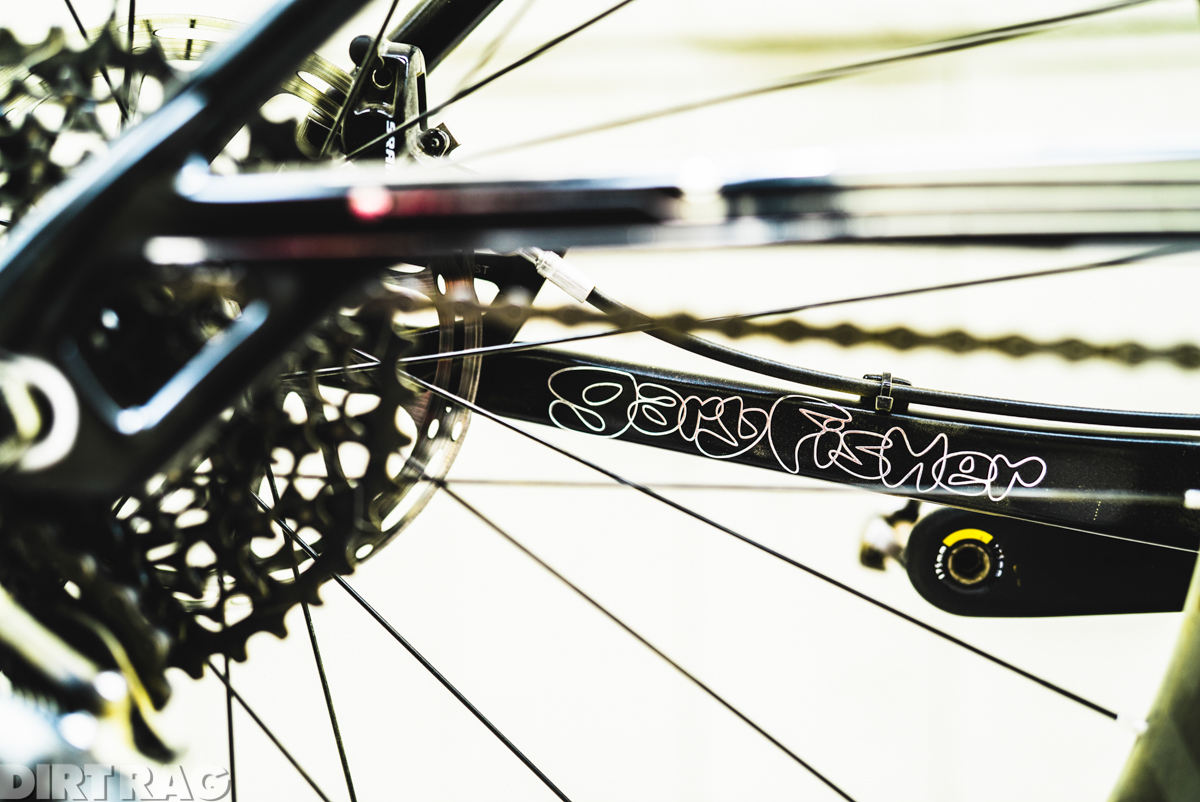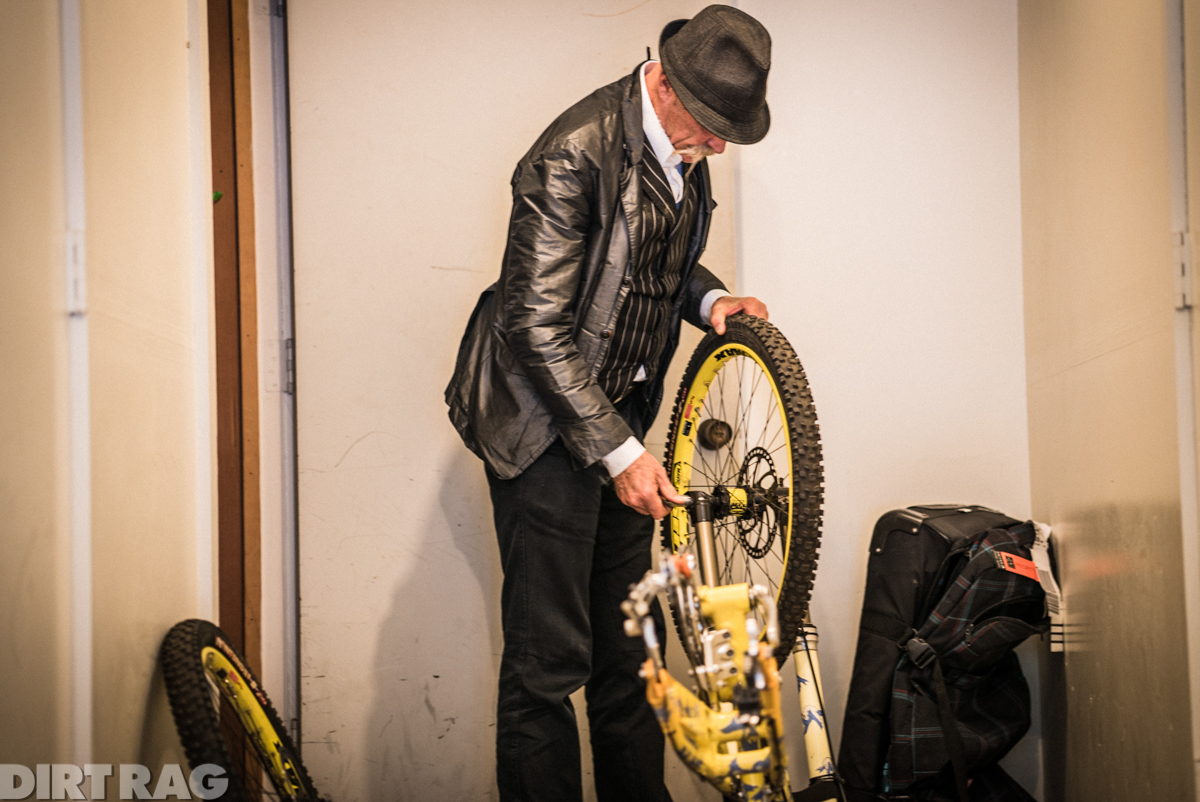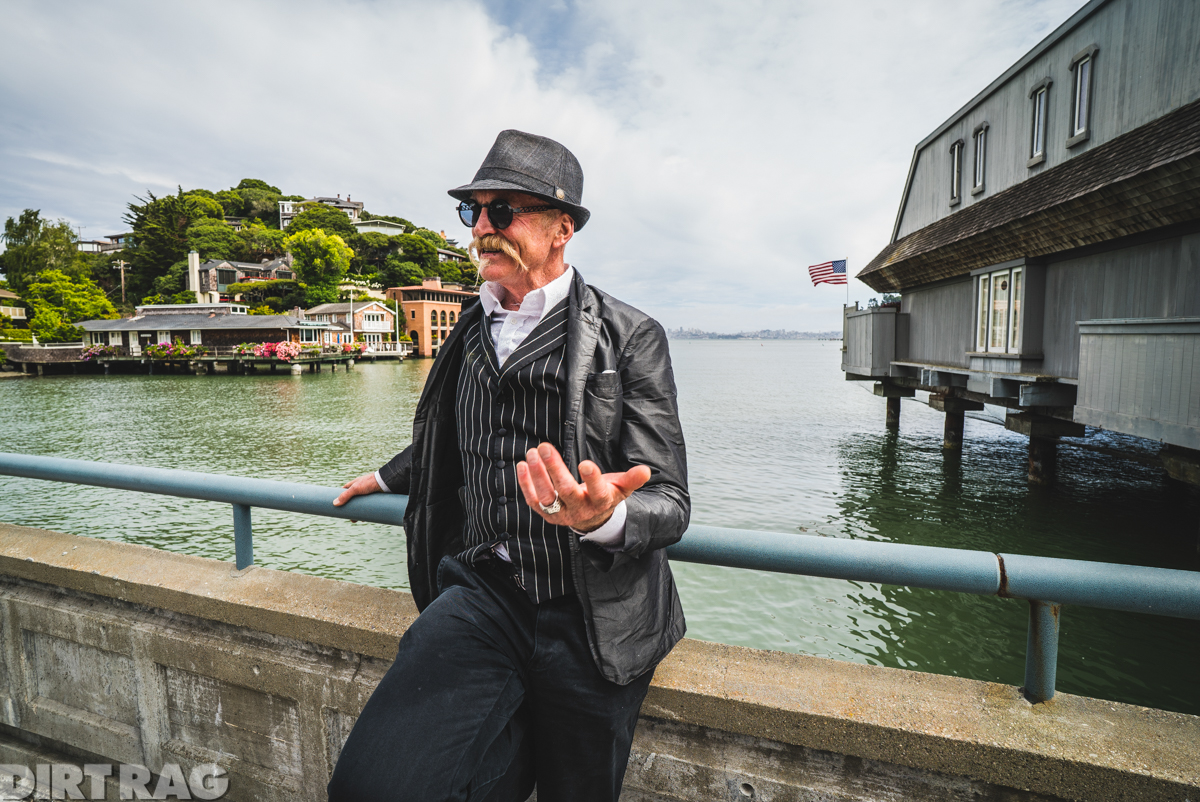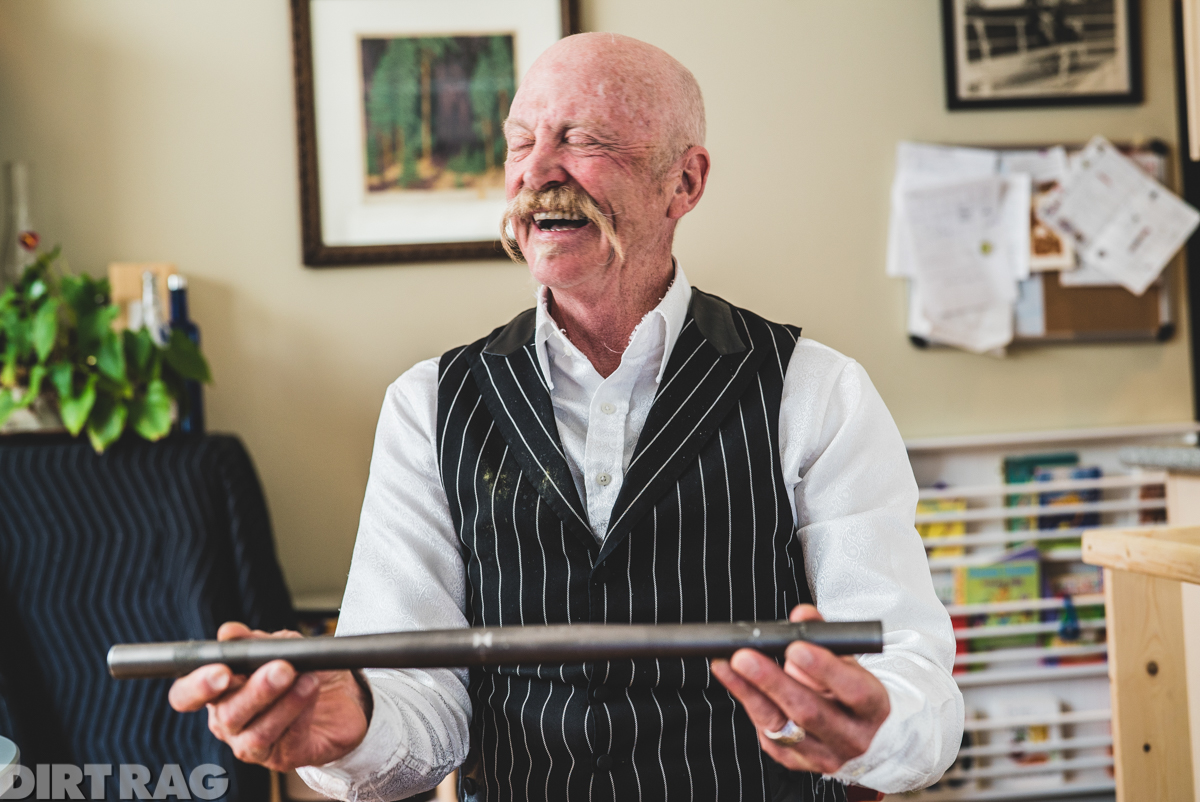A conversation with Gary Fisher: 9 ways he was right (and 1 way he was wrong)
Originally posted on October 9, 2017 at 1:40 amInterview by Patrick Brady, photos by Devon Balet

The mountain bike was a thing and would sell
We went high-end. Gary Fisher bikes were super expensive. I mean, come on, you could buy a full Campagnolo-equipped Colnago for 450 bucks in 1979. You could buy a Ben Serotta super-nice custom bike, complete, for $995—Mavic rims, full Campagnolo. Our bikes started at $1,320, and I’d say to people, “You don’t want a cheap parachute, do you?”
And we’d have a lot of exotic equipment on it and we had beautiful paint jobs. You know, fillet-brazed Tom Ritchey frames. It was beautiful. I had all types of stuff — anodized black and gold, powder-coated black … I was doing a black bike for this super-high-end boutique in Beverly Hills called Maxfield’s. And so I agreed not to do any black bikes except for them. I took the black equipment and made tiger stripes, a bumblebee bike with a yellow frame and a zebra bike. You could have a silver group or as much silver as possible. That would look really good on some frames. This other one was totally blacked out — [this] murdered-out black bike. It killed. I did the original camouflage bike. Yeah, it was good.
Later we did a bike for Sammy Hagar, the Red Rocker, totally red with custom Suntour equipment that was completely murdered-out black.
The more we scratched the surface, we found people who wanted to do exactly the same thing we did, but they didn’t pull it off. You needed good design, and we adapted every high-end part dimension there was— classic English threads, English headset dimensions, that sort of thing — because that would put us in the department of “Well, this is serious stuff. It’s not a joke.” It’s not a BMX bike; it’s not a kid’s bike, because the guys we were trying to reach were traditional bike- shop people, and especially the highest-end ones. I knew a lot of these guys from my days of racing. East Coast, Midwest—they knew bikes; they knew what they were doing.
And so those were my peers; I had to make a bike that worked for them.

Bigger headsets are better
It’s some basic logic. I was spec’ing tubing and I had computer programs that told me what type of wall thickness, what type of modulus of elasticity, I’d get out of this thing, and weight per and all those things, and by doing it we stiffened up the [fork] blades and the stems and the handlebars about double.
135 mm spacing makes a wheel stronger
When we started, the spacing in the rear was 125 mm for a five speed or a six speed, and we were going to seven speeds and eight speeds, so I’m saying, “Wait a minute.” We first went to 130 mm and then 135 mm, and it was all to get the triangulation in the wheel and make a stronger wheel. Shimano made it available to everyone. I was the guy that pushed that with them. You know, that time was like … it was like, “Come on!” This is way too easy to do. All those wheels that got [the spacing] lasted. That was still in the cantilever-brake time.

Stronger brakes are better and the Shadow derailleur
When Shimano did V-brakes, their guys were saying, “Oh, this is too strong,” and they put a modulator on it, and I said, “No, no, no, you can never make brakes too strong.” Remember that; keep remembering that. Or like the Shadow derailleur. [This is the technology that brings the derailleur in closer to the cassette, giving it more protection from knocks and damage. It predated Shadow Plus, which added a clutch mechanism, by a few years.—Ed.] Yeah, that was fun. So I said, “Why is it every year you make these derailleurs and when I lay down the bike it’s the first thing that touches the ground?”
Then, the next year [2008], Shimano did Shadow and they said, “We had that little conversation with you and we got real serious about it.” And that’s why they did it. You know, to me it’s like the stupidest thing that is hanging off, it’s the first thing that’s going to touch.

Bigger wheels are better
It was something that was never settled in the first place: wheel size. I mean, back in the ’70s, I remember sitting at the top of Pearl Pass with Charlie Cunningham; I was looking at Charlie, saying, “You know, if we get a wheel that’s, like, 12 feet tall, it would work here really well.” The boulders are almost as big as the wheels. This is crazy. I’d love to be able to get a bigger tire. It just made sense, because you look at bikes in history and they had all kinds of sizes of wheels, and the way technology was, we were still using steel rims. We were using drum brakes and steel rims.
We gotta keep coming up with new things all the time—oh, my God, all of the time. But I’m into “Let’s get back to fundamental research.” A few years ago people in the companies were saying, “Well, Gary, you ever think 29 will be for downhill?” I said, “Look, nobody knows. Nobody’s built the proper downhill bike in 29, so I can’t answer that.”
I made 10 original 29ers, but we didn’t call them 29ers. We also made five 650b bikes and people were like, “Well, that’s sort of weird.” It was really funny. That was all an offshoot of it.
I wanted to do it right. I wanted to do it with a tire that was the same sort of tire, and we’d had a lot of experience with WTB, who was sponsoring our team, and we used the Nano Raptor. So everybody had experience with that tire—how it handled, how it felt, how fast it was and everything—and I wanted to build at least a pair of bikes, A/B ’em really well. That is, the bikes were completely
comparable from one bike to the other and the only difference was going to be wheel size.
I was at Eurobike recently and I saw Mark Slate [one of the founders of WTB] and I said, “Mark, we’ve been talking about this for 15 years, 20 years.” You know? Sometimes stuff takes this long. It’s really stupid. You have to just check stuff out. And that’s all I wanted to do. I said, “Hey, I’m sick of talking about this. Let’s check it out, see what works or doesn’t.” So I built the bikes in the early 2000s and spent six months with a Polar heart-rate monitor and two bikes that were as identical as possible, riding the same courses, different courses, and learning about them. And what I learned was the 29er was about three to five percent faster on a real regular basis, and I was like, “Wow, this thing’s faster!” I was really surprised that it was faster on pavement, too. It’s crazy. You know, downhill, pavement and climbing, it was really fast, and then I really began to appreciate once again how much traction has to do with not losing your energy, because you lose a ton of energy when you’re going uphill and a wheel skips.
The wheel-size thing—the funny thing people don’t realize, too—I went to the UCI governing body!
I had to go to those guys because they had a rule on the book that said a mountain bike could have no larger than a 26-inch wheel. It was the year I broke my wrist [2003] because I got so excited because they went with my rule [allowing 29ers] that I went on a ride on Mount Tam. I went down; I was going so fast. I mean, nothing could stop me; I crashed [laughs], broke my wrist.
I went to Switzerland twice. We just basically argued that mountain bikes haven’t been developed, you know? They’re [UCI] saying, “We’re really afraid that we’ll have ‘cross bikes.” Well, your courses suck; you got to do a better job. That’s not a mountain bike course. Get a mountain bike course. So I’d been doing more of that. I’d go in and I’d go see the higher-ups and just read them the riot act and say, “Look you’re going to do this or you’re going to die.” And they did it a lot of the time. [Laughs, smacks table with fist.]

Mountain bikes need to handle right
We had rigid forks that had Campagnolo rear dropouts. Big, long, horizontal dropouts. Then you move the wheel back and forth till you found the right offset. I said to Paul Turner [founder of RockShox], “I gotta figure out the offset, man.” It would always be the last thing I’d mess with on the bike because it was the single most effective way you could change how a bike handled. So I wanted Paul to make one of the sliders; he said, “Aw, I can’t do that, but I’ll send you some different crowns.”
So he sent me a bunch of different crowns. We played around and played around and it took about three months to figure out 38.1. And so that became production. Then everybody started using it—I mean, everybody— because it worked.
And that’s a whole other funny story, because then you realize just how incredibly haphazard things can be at times because that’s a huge difference in how a bike will feel. And most people like it one particular way or another, but not everybody. And you know, that’s the other funny thing you find out, because what we’ve got is mostly neutral, which is really good, and the Trek bikes all ride close to the same. I like that. I travel around and pick up different bikes. They’re not always the same model, but they tend to handle the same way. And we got really good at that; it comes from the road side, because the road riders, they really want to be able to have different models of bikes handle the same and everything.

Four-bar linkage suspension
On a bicycle, I think we did it first. Mert Lawwill had done it already on a motorcycle, so we collaborated. That bike [the 1990 Gary Fisher RS-1] had a lot of stuff that was ahead of its time. It didn’t work that well, unfortunately. It had a big, wide bottom-bracket shell, 101 mm; it had a 14 mm rear axle that Campagnolo made—a big oversized one. I was trying to stiffen up the rear end on it. [Sighs.] Man, what a crazy bike that was. It had a disc brake that was — [Sighs.] It didn’t work. [Laughs.] It was a problem.
That bike—it did have some incredible, uncanny powers, and it was that whole virtual pivot-point thing going on. It worked well; it had some good motion as long as you kept everything clean.
And Mert, he worked with our racers, and I went to Japan seven times with him. I mean, he lost a lot of money on that project, but I loved it. You know, I was bound and determined because I knew this was going to be the future. But these projects, man—it wasn’t until 10 years after that that we sold a lot of dual-suspension bikes; it’s a sort of a 10-year thing. I’m tellin’ ya, man. It’s like sometimes you know things can be completely right, but people don’t believe in it, and it just takes a long time to develop the whole thing.

Longer top tubes and shorter stems descend better
That’s once again one of these funny things of us knowing our own history to know that we really didn’t research it in the first place. And that’s to say the original mountain bike geometry—when I say mountain bike, you know, the whole craze started in Marin County and everything—that was Schwinn Excelsior X geometry from before World War II.
That was a good-handling bike—68-degree head angle, 73 [degree] seat angle, really long chainstays at 18.5 inches; the front end was pretty short and [it] met traditional road bike measurements. With the traditional road bike they were doing things like varying the seat angles and chainstay lengths and head angles and offsets. You have to remember the old Schwinn Excelsior X: It came in one size.
So we started making bigger frames and smaller frames and everything, and then what happened, though, was when we made that first fork with Paul Turner, that was where we used 71-, 71.5-degree head angles. I mean, we were just coming out of the days of John Tomac and his Mongoose’s 73-degree head angle. Yeah, they actually made a bike one year that was that steep. Tomac could ride it, but nobody else could ride it; it was really twitchy.
We had a geometry that was super popular; in 1987, Mountain Bike Action named it the best all-time NORBA race geometry. It was the Fisher Procaliber; it was this sort of a hybrid between a road bike and a mountain bike — the Schwinn Excelsior X, except the head angle had gotten steeper, so it was a 71-degree head, 73-degree seat, and the top tubes were various lengths, but nothing super long, and it had a 150 mm long stem.
So one day I’m out on a ride, years later, and I go over the bars a couple of times and I say, “You know, this is all stupid. This wheelbase has got to be longer. The stems are stupid like this.”
We had to try some things on the outside edges, and as a company, we did; we built about 50 bikes. It was crazy. We convinced the higher-ups there had been no rhyme or reason to how we developed geometry; we just blended one thing with another that didn’t really need to be blended, so we developed our [Genesis] geometry. Basically we found having real short chainstays helped, having a real long front-center, because the bike can still be lively and traction greatly improved when you’re climbing, and that counted for a lot, and slacker head angles are your friend, especially descending; they make it a lot less nervous. What I’m proudest of is just making frame builders think about this stuff.

The one time Gary Fisher was wrong
OK, there was Hite Rite, right? We used Hite Rite, and because we used Hite Rite, everybody used Hite Rite. Joe [Breeze] bought his house [by helping invent the Hite Rite], but Hite Rite had a problem. The nylocs [nuts] would get loose. The whole thing would become wiggly. You had to get off the bike and get your wrenches. People didn’t like that. So I started working with this guy, Strong Seatpost, in Japan. He says, “Hey, check this out.” He made a dropper post. This is, like, 1983, and he made a dropper post [with a] cable-operated lever. I said, “No, no, no, I’ve got to protect my guy Joe. I’m doing too much business with him.” I said, “Forget it. I don’t want it.”
So I didn’t do it.

You gotta make friends, be an advocate
A lot of it is you just gotta make friends with people first. That’s the big thing, and it takes time. Otherwise you can spend years beating your head against the wall. That’s part of the problem we had early on with the 29er. There were some guys in the movement that were just so on the case of all the journalists that those journalists said, “Nah.”
It’s a privilege I have; let’s put it that way. It sort of surprises me, but I get along with a lot of people in government and federations and all that. I think a lot of them see me as a maverick of sorts, but also one that’s capable. And I have enough experience to see things; you see how the powers work and how they grind and everything, and what I’m trying to do is more like [what] Walt Disney tried to do. He was just a great example to people, you know, about how fantasy and dreams can really power people.
That’s, I think, what I do, now more than ever, is I travel great distances and give people permission to follow their own dreams, because I’ve got a lot of people that are thinking on the same wavelength as I am and they’re not alone. A lot of these ideas are not mine as the very first, that’s for sure, but that’s quite all right, because they’re the right ideas.
It’s been said the only movements that really stick are the grassroots movements, and the grassroots movements are the ones that people think of independently on their own because they’re the right things to do. I really like those people. They’re real special. It’s really difficult because a lot of people can’t envision what those people have envisioned, and that’s really our duty — to try and make it clearer — and it’s a great art. That’s our storytelling. You always have to explain your story. While there are a percentage of people that can get it from just the verbal—you know, with just inkling—but you can’t get everybody that way. Not even a majority.
But hey, emotion rules, man.
